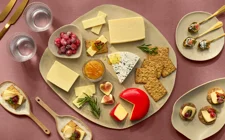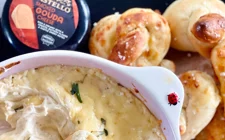
Roquefort (PDO)
What is Roquefort (PDO)?
Visually reminiscent of the limestone cliff sides in which it is aged, Roquefort illustrates French artisanry like few others. A favorite among kings and popes, this classic blue mold cheese is made from sheep’s milk and is easily recognized by its blue veins stretching across its moist and crumbly body. It is creamy and aromatic, complex and intense, with sharp and tangy nuances.
While the unique characteristics of Roquefort are largely imparted from aging in caves near Toulouse in the southern part of France, the milk of the Lacaune sheep also plays a large role in the outcome of flavors. Grazing on pastures in Occitanie, the sheep are known to produce milk of sturdy character, rounded flavors and a high yield.
Pair Roquefort with honey and zesty apples. The salty profile of Roquefort also sits in perfect tune with meat.
How Roquefort (PDO) is made*
Strict guidelines set the tone for how producers make Roquefort cheese, and following these is key to achieving the official label.
Tankers collect milk every day and deliver it to the creameries, fresh and unpasteurized. It is heated and poured into closed vats, then blended with a mixture of culture, penicillium roqueforti and rennet. Not only does this curdle the milk, the yeast also triggers the fostering of blue mold from the center of the cheese. Once firm, the curd is milled and shaped by molds that are left to drain in storage. A generous brine of salt is applied by hand, preventing an excessive growth of mold on the rind. Shortly after, the brined cheese is pierced with steel needles, allowing the blue veins to develop and breathe.
Naturally formed caves in the cliffs overhanging the village of Roquefort serve as the home of the cheese during aging, allowing it to absorb filtered moisture and flavors as time passes. Having aged for 20 days, the cheese is wrapped in foil, slowing the development of the blue mold. This allows the texture to soften, giving Roquefort its creamy consistency. After 3 months of ripening, the foil is removed, and the Roquefort is sent out to shops.
*Castello does not produce or sell Roquefort (PDO).
Pick another Blue Mould Cheese
If you appreciate the qualities of Roquefort there are other cheeses you might enjoy.
Gorgonzola (PDO), an Italian classic, offers a range of flavors from mild to pungent. Known for its intricate flavors and creamy consistency, it works well in salads, on steaks, or on a cheeseboard.
Stilton (PDO) is vibrant, strong, and full of personality. It has a robust profile with earthy hints of mushroom, offering a distinct and flavorful experience.
Curious about the world of cheese? Here's everything you need to know about how to store, serve and cut cheese!







